
A megalith is a large stone that has been used to construct a prehistoric structure or monument, either alone or together with other stones. There are over 35,000 structures or arrangements in Europe alone, located widely from Sweden to the Mediterranean sea.

Giants' grave is the name given by local people and archaeologists to a type of Sardinian megalithic gallery grave built during the Bronze Age by the Nuragic civilization. They were collective tombs and can be found throughout Sardinia, with 800 being discovered there.
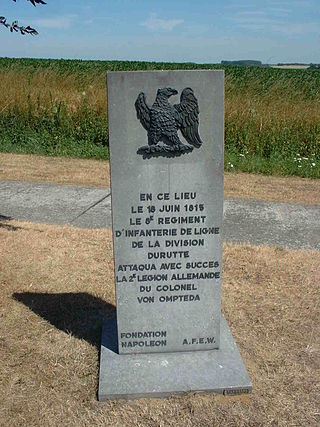
A stele, from Greek στήλη, stēlē, plural στήλαι stēlai, is a stone or wooden slab, generally taller than it is wide, erected in the ancient world as a monument. The surface of the stele often has text, ornamentation, or both. These may be inscribed, carved in relief, or painted.

Bryn Celli Ddu is a prehistoric site on the Welsh island of Anglesey located near Llanddaniel Fab. Its name means 'the mound in the dark grove'. It was archaeologically excavated between 1928 and 1929. Visitors can get inside the mound through a stone passage to the burial chamber, and it is the centrepiece of a major Neolithic Scheduled Monument in the care of Cadw. The presence of a mysterious pillar within the burial chamber, the reproduction of the 'Pattern Stone', carved with sinuous serpentine designs, and the fact that the site was once a henge with a stone circle, and may have been used to plot the date of the summer solstice have all attracted much interest.

Tharros was an ancient city and former bishopric on the west coast of Sardinia, Italy.

Su Nuraxi is a Nuragic archaeological site in Barumini, Sardinia, Italy. Su Nuraxi simply means "The Nuraghe" in Campidanese, the southern variant of the Sardinian language.

Dorgali is a comune (municipality) in the Province of Nuoro in the Italian region Sardinia, located about 230 kilometres (140 mi) northeast of Cagliari and about 38 kilometres (24 mi) east of Nuoro in the Seaside Supramonte mountain area.

The Nuragic civilization, also known as the Nuragic culture, formed in the Mediterranean island of Sardinia, Italy in the Bronze Age. According to the traditional theory put forward by Giovanni Lilliu in 1966, it developed after multiple migrations from the West of people related to the Beaker culture who conquered and disrupted the local Copper Age cultures; other scholars instead hypothesize an autochthonous origin. It lasted from the 18th century BC, up to the Iron Age or till the Roman colonization in 238 BC. Others date the culture as lasting at least until the 2nd century AD, and in some areas, namely the Barbagia, to the 6th century AD, or possibly even to the 11th century AD. Although it must be remarked that the construction of new nuraghi had already stopped by the 12th-11th century BC, during the Final Bronze Age.

Monte d'Accoddi is a Neolithic archaeological site in northern Sardinia, located in the territory of Sassari, Italy. The site consists of a massive raised stone platform thought to have been an altar. It was constructed by the Ozieri culture or earlier, with the oldest parts dated to around 4,000–3,650 BC.
The Ozieri culture was a prehistoric pre-Nuragic culture that occupied Sardinia from c. 3200 to 2800 BCE. The Ozieri was the culmination of the island's Neolithic culture and takes its name from the locality where early findings connected with it have been found, the cave of San Michele near Ozieri, in northern Sardinia. The Ozieri existed contemporaneously with the Arzachena culture, sharing some similarities, and its influence also extended to nearby Corsica.
Poggio Colla is an Etruscan archaeological site located near the town of Vicchio in Tuscany, Italy.

The Giants of Mont'e Prama are ancient stone sculptures created by the Nuragic civilization of Sardinia, Italy. Fragmented into numerous pieces, they were discovered in March 1974 on farmland near Mont'e Prama, in the comune of Cabras, province of Oristano, in central-western Sardinia. The statues are carved in local sandstone and their height varies between 2 and 2.5 meters.

Tiscali Village is an archaeological site situated in Sardinia, in the comune of Dorgali.
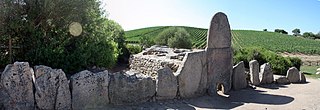
Coddu Vecchiu is a Nuragic funerary monument located near Arzachena in northern Sardinia, dating from the Bronze Age. The site consists of a stele, stone megaliths and a gallery grave, and is one of the larger Nuragic Giants' graves on the island. The Nuraghe La Prisgiona is located nearby.
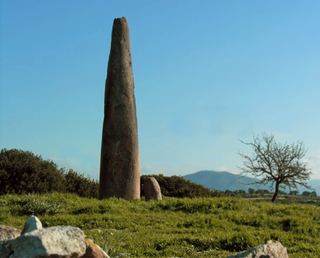
The Pre-Nuragic period refers to the prehistory of Sardinia from the Paleolithic until the middle Bronze Age, when the Nuragic civilization flourished on the island.
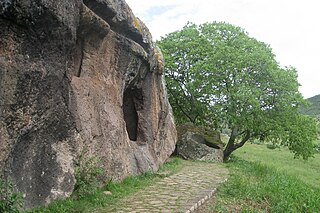
The necropolis of Sant'Andrea Priu is an archaeological site located on the south side of the fertile plain of Saint Lucia, in the municipality of Bonorva, Sardinia. The complex, one of the most important of the island, is composed of twenty domus de janas; one of them with its eighteen rooms appears to be one of the largest hypogean tombs of the Mediterranean basin.
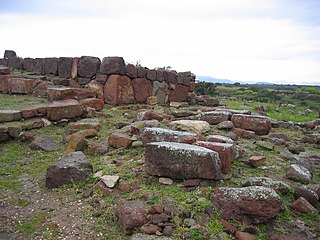
Monte Sirai is an archaeological site near Carbonia, in the province of South Sardinia, Sardinia, Italy. It is a settlement built at the top of a hill by the Phoenicians of Sulci. The history of studies in Monte Sirai has a very precise date: the fall of 1962, when a local boy casually found a female figure carved on a stele of the tophet. Following further inspections, in August 1963, the local Soprintendenza and the Institute of Near Eastern Studies of the Sapienza University of Rome started excavations, leading to a fairly comprehensive study of the entire town.

The Giants' grave of Su Mont'e s'Abe is an archaeological site located in the municipality of Olbia, in the Italian province of Sassari.

The Nuragic sanctuary of Santa Vittoria is an archaeological site located in the municipality of Serri, Sardinia – Italy. The name refers to the Romanesque style church built over a place of Roman worship which rises at the westernmost tip of the site. The Santa Vittoria site was frequented starting from the first phase of the Nuragic civilization corresponding to Middle Bronze Age. Subsequently, from the late Bronze Age to the early Iron Age, the place became one of the most important expressions of the Nuragic civilization and today it constitutes the most important Nuragic complex so far excavated.

The Menhir Museum, or Civic Archaeological Museum of the Menhir Statues, located in the Aymerich Palace in the village of Laconi, is a unique museum of its kind for its rich collection of steles found in the Laconi area, with the first discovery in 1969.























